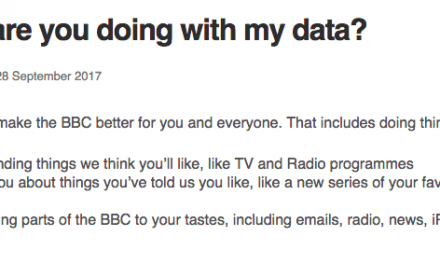As part of my current master degree programme in media studies at the Film University Babelsberg, Germany, I had the opportunity to learn about research in television and the television industry at the conference Redefining Televisuality: Programmes, Practices, Methods. I was particularly interested in the panel on Netflix global strategies.
‘I am wearing my academic hat, but I am a producer’ is how Joanna Szymańska introduced her talk about investment obligations for global streaming services as a wind of hope for the peripheral markets in Europe with Poland as a case study. In the panel ‘Netflix’s global strategies’ scholars focused on Netflix’s strategies looking at its investments in Poland and internationally adaptable formats. Producer and director Joanna Szymańska started off the panel with her first academic lecture ever. She started her PhD on Netflix’s influence on producers’ creative freedom (with Poland as a case study) only last year at the Lodz Film School. As a student, I’ve never been in touch with the Polish media industry, but my question why Poland was particularly interesting as a case study was quickly answered. Poland is a large digital periphery with a TV landscape consisting mainly of dramas with conservative storylines. Szymańska stated that the so-called ‘TAN values’ – traditional, authoritarian, and nationalist – are prevalent in Poland, rather than the gal values – green, alternative, and liberal. With streaming services now investing in local European productions, Szymańska was able to directly answer the question of whether investment obligations for global streaming services represent a wind of hope for peripheral markets in Europe, with a clear ‘no.’ She explained the processes of investment by Netflix in the Polish market and how the market figures of Polish Netflix productions have overtaken those of the Polish Film Institute. Streaming service, available from 2016 in Poland, invested 109 million Euros in 2020/2021 and created 2600 industry jobs (Hollywood Reporter, May 2022). According to Szymańska this is a ‘breath of fresh air that Netflix has brought into Poland. Netflix offered producers the freedom of creativity, a ‘candy sweet trap’, as Szymańska says, because Netflix picked formats that an average person would watch. As the Polish film market shrank severely in 2020 during the pandemic, the market has less money than before. Speaking as a producer, Szymańska stated that ‘something had to start immediately – better this than nothing’. Funded productions, however, were difficult to reconcile at the political level. Company lists were kept secret in order not to publish the amount of money Netflix invested in Polish productions leading Szymańska to the conclusion that new financing opportunities come with the loss of creative freedom in film production. On the other hand, Netflix is offering opportunities to produce topics that are difficult to get commissioned as a result of the rightward shifts in Polish politics, including queerness or a focus on diversity.
A different view to Joanna Szymańska’s presentation, was put forward by Sylwia Szostak. In her presentation ‘Poland’s Invisible Fiction in the Streamers Age’ she took a productive-focused view on the Polish streaming industry. Szotak created a good connection to Szymańska’s presentation and gave an extensive insight into the development of the Polish industry (also in relation to the Western streaming industry). Partially as a result of the investments by Netflix and other streamers, Poland has become one of the largest markets for video on demand in Central and Eastern Europe. As a result, Netflix has opened up new opportunities for producers to exploit creative freedom rather than being restricted by government regulations. Szotaks highlighted that producers complain about the restriction of creative freedom in Poland, an argument that had also been put forward by Szymańska. On the other hand, Szotak claimed that TV producers of traditional content don’t experience less creative freedom. The opportunity to freely produce formats and adapt them commercially cannot be reconciled with the narrative of reduced creativity in Polish television. ‘Netflix needs Poland’ explained Szotak, as the Polish market is the largest market from the point of VOD subscriptions. In comparison with Western countries, Poland’s streaming industry is generating significant income. For the past couple of years, online video subscriptions have risen with 3 million paying accounts prompting Netflix into engineering a hub in Warsaw to hire people with Hungarian/ Czech language skills. Since Netflix’s launch in Poland in 2016, Poland never had ‘so many TV shows premiering’, according to Szotak. Therefore, she described the development as ‘impact’ on, rather than ‘disruption’ of the Polish media market. Netflix is looking for genres that a TV producer could never produce within the old media market. A very popular example is the show High Water (2022), which became almost instantly a global hit. It was a special case for Poland, as the country never had so much global exposition before. A ‘ripple effect’, a sense of excitement spread among producers, who typically produce traditional television. To conclude: due to its status, Netflix does not have to subordinate itself to the requirements of Polish state television. This enabled producers to include different values in their production such as generic diversity and bring higher production values to products and to export them globally.
After two insightful presentations, I was surprised by my lack of knowledge on the streaming market in Eastern Europe. The presentations provided an in-depth insight into the advantages and disadvantages of Netflix as a production opportunity for Polish producers. In the discussion, I particularly liked the juxtaposition of perspectives: the restriction of creative production by Netflix commercial ideas from Szymańsk’s point of view, as well as the expansion of possibilities and further development of Polish television from Szotak’s point of view. The next presentation shifted from Eastern Europe to the global market.
Frédérique Khazoom is a PhD candidate ‘who is more able to talk about global strategies’ in between two continents, at the Université de Montréal and the University of Amsterdam. In her presentation ‘Televisuality on a global scale: Netflix’s “local-language” strategy’, she presented the production of ‘Collections’ as a category on Netflix. She focused on Criminal (2019), a series that is a multiple languages four-country project by Netflix involving the United Kingdom, France, Germany and Spain. The series were shot in the respective languages and actors in the same setting, the Netflix production hub in Madrid, by Idiot Lamp Production. Khazoom posed the question what does it mean to produce a series as one product divided by four. I found this highly interesting question difficult to answer, as it required a deep dive into the industrial matter and had to be dealt with in many different ways within 15 minutes. On a business level, Khazoom explained, a TV license is usually issued for a 1 to 1 format, but in the collection case, Netflix built multiple licensing potentials for a local TV format by using strategies to broadcast local products globally. Using Jean Chalaby’s format licensing business model with the formula global to local to global production, Khazoom explained the distribution strategy and accessibility on a global level. To keep each production as highly beneficial for Netflix, each product is produced in the same set, with the same visual style. Additionally, the style of the respective production has to be nationally appealing, and each version of Criminal is therefore tailored to the respective target audience. Frédérique Khazoom showed an in-depth picture of the context that allows Netflix to expand globally and enforce its language strategy also on a stylistic and aesthetic level.
The fact that these three presentations were curated together in a comprehensible way was particularly evident in the discussion that rounded off the 3-day conference. Some take-aways of the panel were that Polish productions need to be “Polish enough” to be realised under the particular conditions there, as well as sufficiently funded. Moreover, the discussion raised the crucial question: How do we work with increasing productions for streaming providers in the future? What value does or should a (form of) production have and should it be transferrable to other places? John T. Caldwell asked a question that preoccupied me afterwards: how do film schools respond to the global development of Netflix since ‘we have to feed the industries’ (Whereby I must note that at that moment the counter-question popped into my head: do we?). The discussion showed that film schools are already dedicated to working towards streaming productions. In Poland, Netflix is targeting film schools, the Polish scholars noted – but also that producing for streaming platforms is ‘TV production for dummies’ – ‘they have the recipe’ and they can directly tell what ‘Netflix is (not) looking for.’
The discussion could have continued in many ways and had sparked interest and engagement by the audience. The contributions and discussions made me and the other participants curious about the productions that are created today and will be watched in three years.
Klara Liebig studied theater studies at the Freie Universität Berlin. As she increasingly focused on film and television in her Bachelor’s degree, she decided to do a Master’s in Media Studies at the Film University KONRAD WOLF.





